ECU MERCEDES-BENZ C-Class SEDAN 2013 W204 Owner's Manual
[x] Cancel search | Manufacturer: MERCEDES-BENZ, Model Year: 2013, Model line: C-Class SEDAN, Model: MERCEDES-BENZ C-Class SEDAN 2013 W204Pages: 358, PDF Size: 4.85 MB
Page 15 of 358
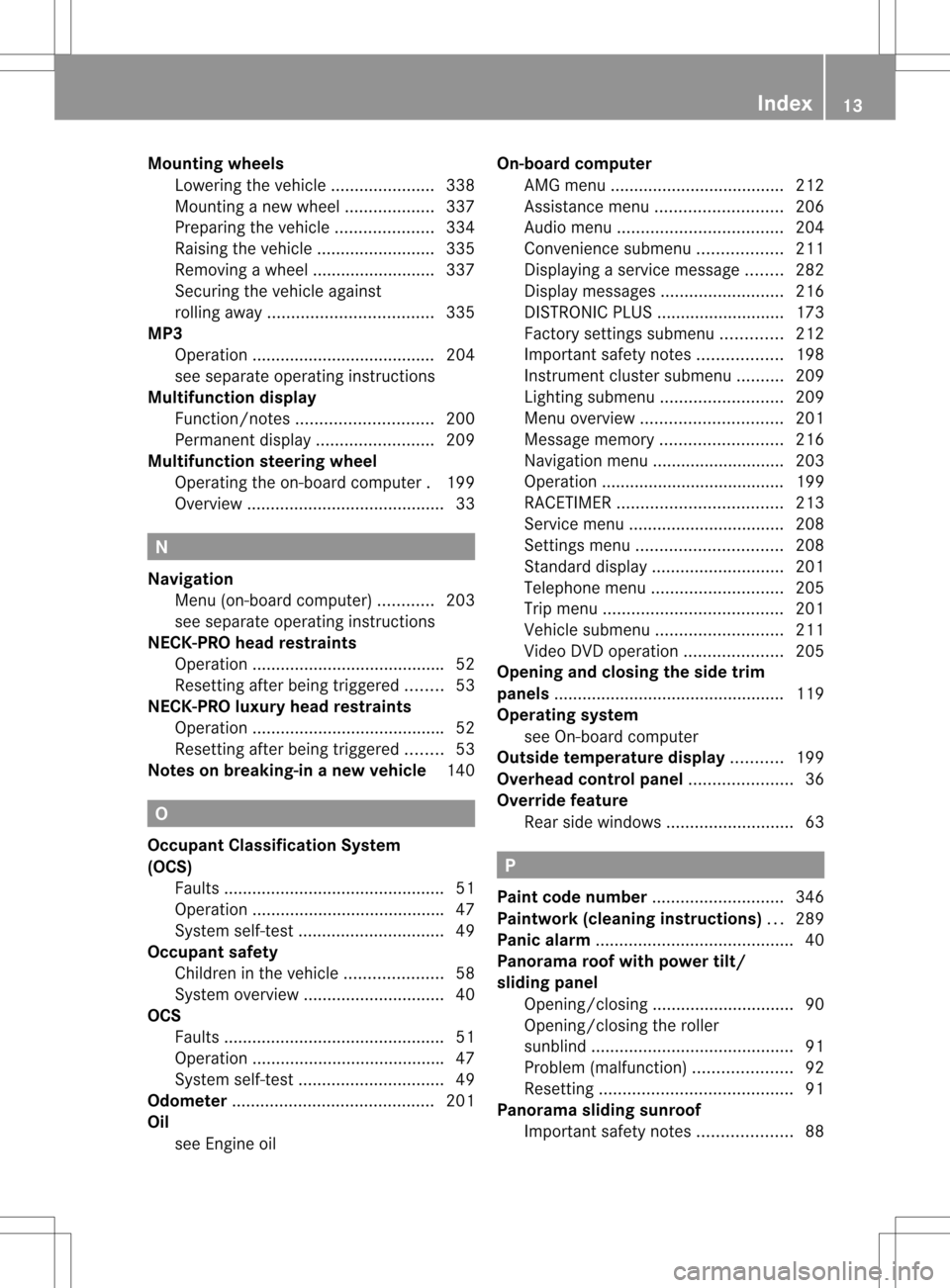
Mounting wheels
Lowering the vehicl e...................... 338
Mounting anew wheel ................... 337
Preparing the vehicle .....................334
Raising the vehicle .........................335
Removing awheel .......................... 337
Securing the vehicle against
rolling away ................................... 335
MP3
Operation ....................................... 204
see separate operating instructions
Multifunction display
Function/notes ............................. 200
Permanent displa y......................... 209
Multifunction steering wheel
Operating the on-board computer .199
Overview .......................................... 33N
Navigation Menu (on-board computer) ............203
see separate operating instructions
NECK-PRO head restraints
Operation ........................................ .52
Resetting after being triggered ........53
NECK-PRO luxury head restraints
Operation ........................................ .52
Resetting after being triggered ........53
Notes on breaking-in anew vehicle 140 O
Occupant Classification System
(OCS) Fault s............................................... 51
Operation ........................................ .47
System self-test ............................... 49
Occupant safety
Childre ninthe vehicle ..................... 58
System overview .............................. 40
OCS
Faults ............................................... 51
Operation ........................................ .47
System self-test ............................... 49
Odometer ........................................... 201
Oil see Engine oil On-board computer
AMG menu ..................................... 212
Assistance menu ........................... 206
Audi omenu ................................... 204
Convenience submenu ..................211
Displaying a service message ........282
Display messages ..........................216
DISTRONI CPLUS ........................... 173
Factory settings submenu .............212
Important safety notes ..................198
Instrument cluster submenu ..........209
Lighting submenu .......................... 209
Menu overview .............................. 201
Message memory .......................... 216
Navigation menu ............................ 203
Operation ....................................... 199
RACETIMER ................................... 213
Service menu ................................. 208
Settings menu ............................... 208
Standard displa y............................ 201
Telephone menu ............................ 205
Trip menu ...................................... 201
Vehicle submenu ........................... 211
Video DVD operatio n..................... 205
Opening and closing the side trim
panels ................................................. 119
Operating system see On-board computer
Outside temperature display ...........199
Overhead control panel ......................36
Override feature Rea rside windows ........................... 63 P
Pain tcode number ............................ 346
Paintwork (cleaning instructions) ...289
Panic alarm .......................................... 40
Panorama roof with power tilt/
sliding panel
Opening/closing .............................. 90
Opening/closing the roller
sunblind ........................................... 91
Problem (malfunction) .....................92
Resetting ......................................... 91
Panorama sliding sunroof
Important safety notes ....................88 Index
13
Page 21 of 358

Trunk
Emergency release ..........................84
Important safety notes ....................82
Locking separatel y........................... 84
Opening (automatically from
inside) .............................................. 83
Opening (automatically from
outside) ............................................ 83
Trunk lid
Display message ............................ 239
Opening/closing .............................. 82
Opening dimensions ......................355
Trunk load (maximum) ......................355
Turn signals Display message ............................ 224
Switching on/off ........................... 112
see Turn signals
Type identification plate
see Vehicle identification plate U
Unlocking Emergency unlocking .......................81
From inside the vehicle (central
unlocking button) ............................. 80 V
Vanity mirror (in the sun visor) ........262
Vehicle Data acquisition ............................... 26
Display message ............................ 238
Emergency locking ........................... 81
Emergency unlocking .......................81
Equipment ....................................... 22
Individua lsettings .......................... 208
Limited Warranty ............................. 26
Loading .......................................... 321
Locking (in an emergency) ...............81
Locking (SmartKey) .......................... 74
Lowering ........................................ 338
Maintenance .................................... 23
Parking for a long period ................ 160
Pulling away ................................... 144
Raising ........................................... 335
Reporting problems .........................26
Securing from rolling away ............335 Towing away
.................................. 304
Transporting .................................. 306
Unlocking (in an emergency) ...........81
Unlocking (SmartKey) ......................74
Vehicle data ................................... 355
Vehicle data ....................................... 355
Vehicle dimensions ...........................355
Vehicle emergency locking ................81
Vehicle identification number see VIN
Vehicle identification plate ..............346
Vehicle tool kit .................................. 296
Video (DVD) ........................................ 205
VIN ...................................................... 346 W
Warning and indicator lamps ABS ................................................ 244
Brakes ........................................... 244
Check Engine ................................. 250
Coolant .......................................... 251
Distance warning ........................... 253
DISTRONI CPLUS ........................... 253
ESP ®
.............................................. 246
ESP ®
OFF ....................................... 247
Fuel tank ........................................ 250
Overview .......................................... 32
PASSENGER AIR BAG OFF
indicator lamp .................................. 47
Reserve fuel ................................... 250
Seat bel t........................................ 242
SPORT handling mode ...................247
SRS ................................................ 249
Tire pressure monitor ....................254
Warranty ............................................ 346
Washer fluid Display message ............................ 240
Wheel bol ttightening torque ...........338
Wheel chock ...................................... 335
Wheels Changing awheel .......................... 334
Checking ........................................ 311
Cleaning ......................................... 289
Cleaning (warning) .........................334
Emergency spare wheel .................342
Important safety notes ..................310
Interchanging/changing ................334 Index
19
Page 27 of 358
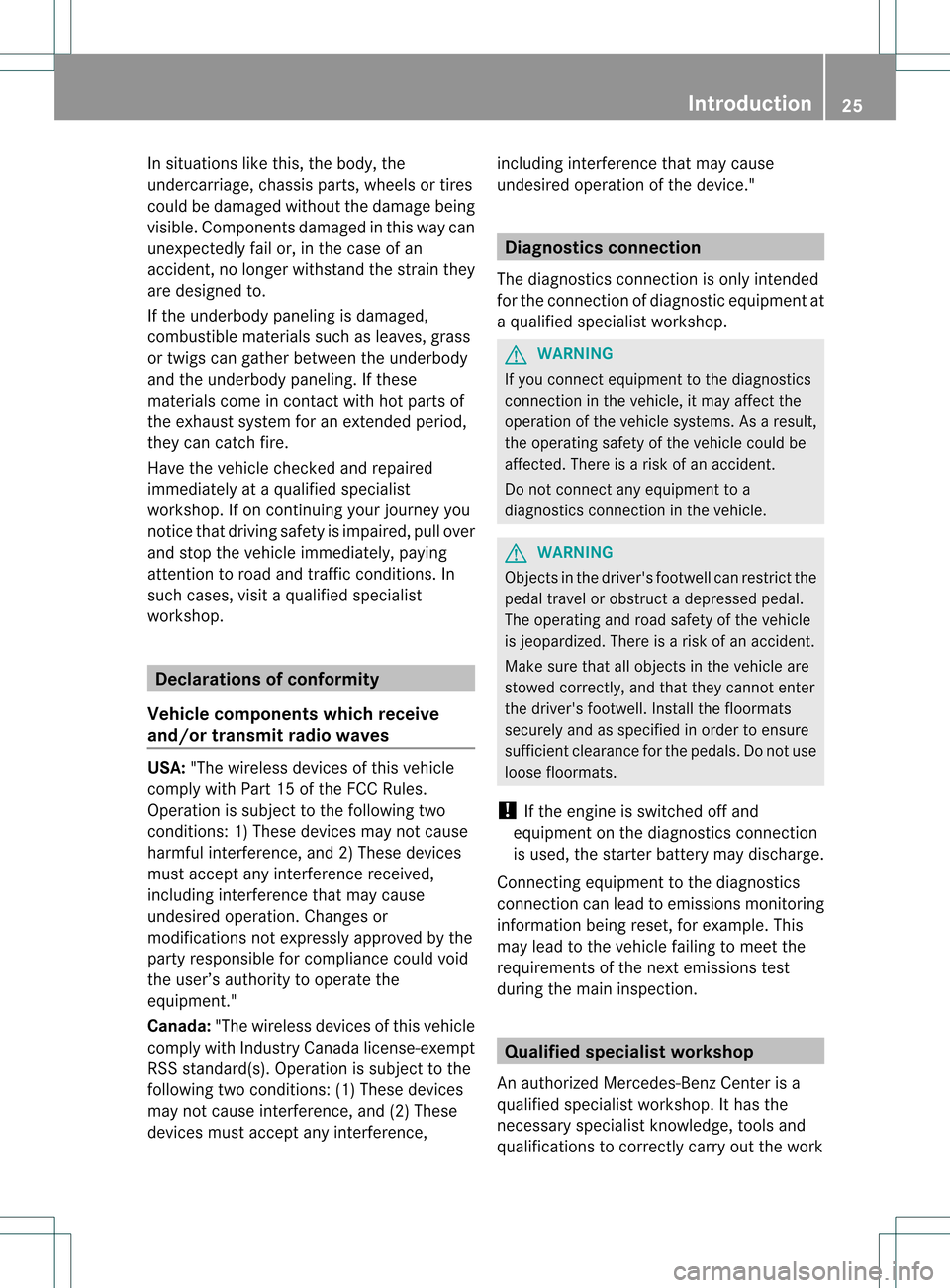
In situations like this, the body, the
undercarriage, chassis parts, wheels or tires
could be damaged withou tthe damage being
visible. Components damaged in this way can
unexpectedly fail or, in the case of an
accident, no longer withstand the strain they
are designed to.
If the underbody paneling is damaged,
combustible materials such as leaves, grass
or twigs can gather between the underbody
and the underbody paneling. If these
materials come in contact with hot parts of
the exhaust system for an extended period,
they can catch fire.
Have the vehicle checked and repaired
immediately at a qualified specialist
workshop. If on continuing your journey you
notice that driving safety is impaired, pull over
and stop the vehicle immediately, paying
attention to road and traffic conditions. In
such cases, visit a qualified specialist
workshop. Declarations of conformity
Vehicle components which receive
and/or transmit radio waves USA:
"The wireless devices of this vehicle
comply with Part 15 of the FCC Rules.
Operation is subject to the following two
conditions: 1) These devices may not cause
harmful interference, and 2) These devices
must accept any interference received,
including interference that may cause
undesired operation. Changes or
modifications not expressly approved by the
party responsible for compliance could void
the user’s authority to operate the
equipment."
Canada: "The wireless devices of this vehicle
comply with Industry Canada license-exempt
RSS standard(s). Operation is subject to the
following two conditions: (1) These devices
may not cause interference, and (2) These
devices must accept any interference, including interference that may cause
undesired operation of the device." Diagnostics connection
The diagnostics connection is only intended
for the connection of diagnostic equipment at
a qualified specialist workshop. G
WARNING
If you connect equipment to the diagnostics
connection in the vehicle, it may affect the
operation of the vehicle systems. As a result,
the operating safety of the vehicle could be
affected. There is a risk of an accident.
Do not connect any equipment to a
diagnostics connection in the vehicle. G
WARNING
Objects in the driver's footwell can restrict the
pedal travel or obstruct adepressed pedal.
The operating and road safety of the vehicle
is jeopardized. There is a risk of an accident.
Make sure that all objects in the vehicle are
stowed correctly, and that they cannot enter
the driver's footwell. Install the floormats
securely and as specified in order to ensure
sufficien tclearance for the pedals. Do not use
loose floormats.
! If the engine is switched off and
equipmen tonthe diagnostics connection
is used, the starter battery may discharge.
Connecting equipment to the diagnostics
connection can lead to emissions monitoring
information being reset, for example. This
may lead to the vehicle failing to meet the
requirements of the next emissions test
during the main inspection. Qualified specialist workshop
An authorized Mercedes-Ben zCenter is a
qualified specialist workshop. It has the
necessary specialist knowledge, tools and
qualifications to correctly carry out the work Introduction
25 Z
Page 29 of 358
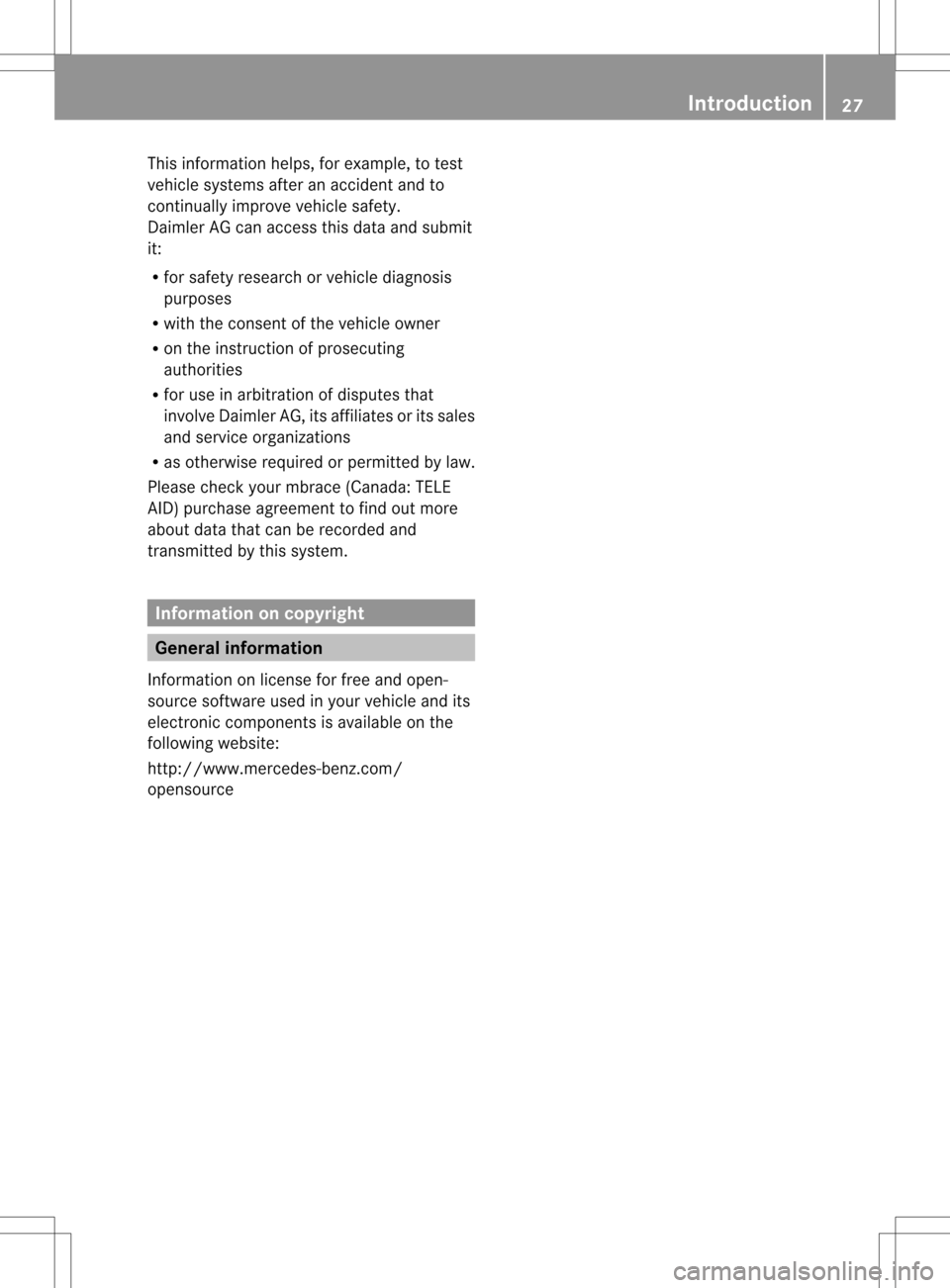
This information helps, for example, to test
vehicle systems after an accident and to
continually improve vehicle safety.
Daimler AG can access this data and submit
it:
R for safety research or vehicle diagnosis
purposes
R with the consent of the vehicle owner
R on the instruction of prosecuting
authorities
R for use in arbitration of disputes that
involve Daimler AG, its affiliates or its sales
and service organizations
R as otherwise required or permitted by law.
Please check your mbrace (Canada: TELE
AID) purchase agreement to find out more
about data that can be recorded and
transmitted by this system. Information on copyright
General information
Information on license for free and open-
source software used in your vehicle and its
electronic components is available on the
following website:
http://www.mercedes-benz.com/
opensource Introduction
27 Z
Page 50 of 358
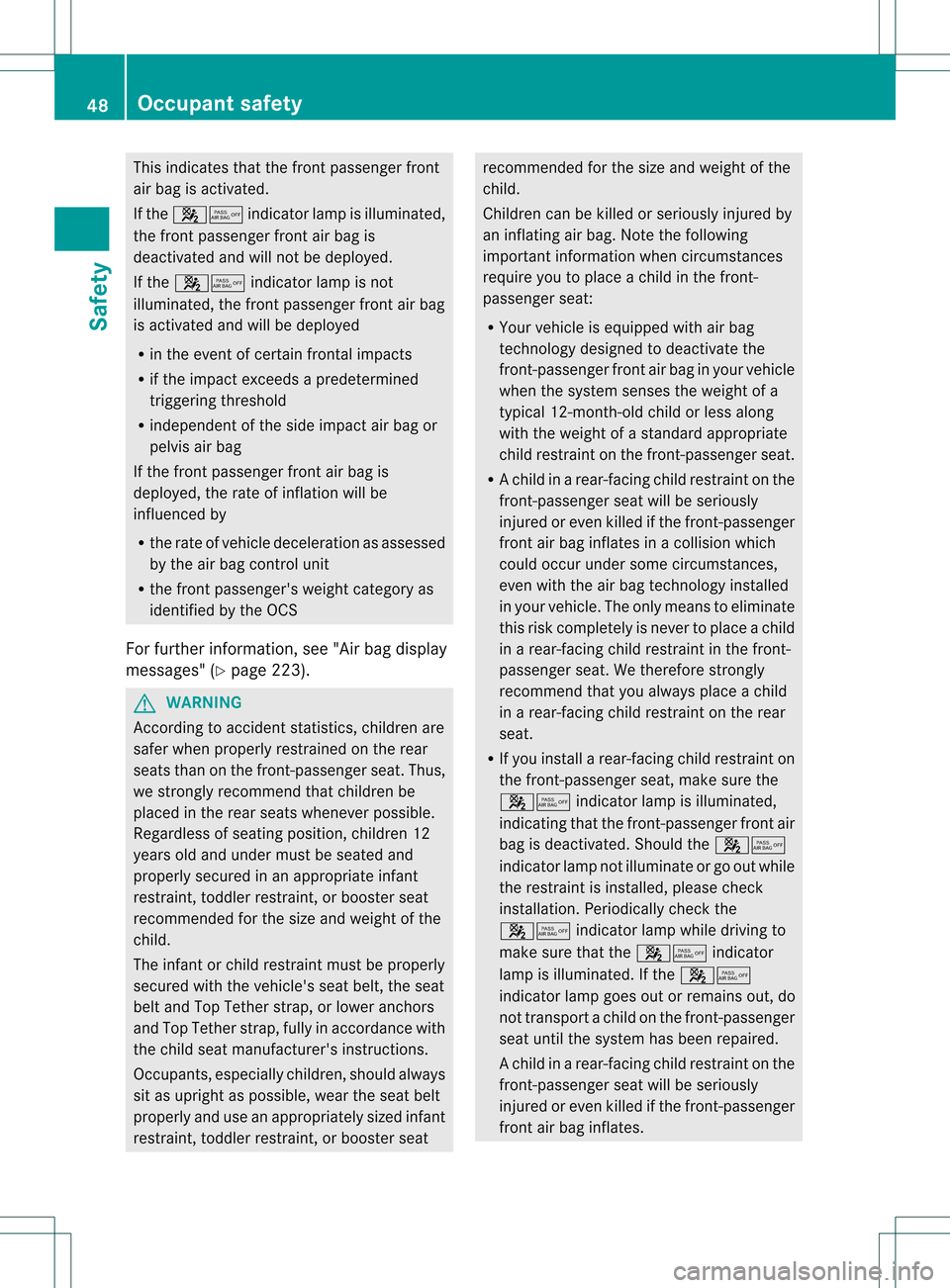
This indicates that the front passenger front
air bag is activated.
If the
0019001B indicator lamp is illuminated,
the front passenger front air bag is
deactivated and will not be deployed.
If the 0019001B indicator lamp is not
illuminated, the front passenger front air bag
is activated and will be deployed
R in the event of certain frontal impacts
R if the impact exceeds a predetermined
triggering threshold
R independent of the side impact air bag or
pelvis air bag
If the front passenger front air bag is
deployed, the rate of inflation will be
influenced by
R the rate of vehicle deceleration as assessed
by the air bag control unit
R the front passenger's weight category as
identified by the OCS
For further information, see "Air bag display
messages" (Y page 223). G
WARNING
According to accident statistics, children are
safer when properly restrained on the rear
seats than on the front-passenger seat. Thus,
we strongly recommend that children be
placed in the rear seats whenever possible.
Regardless of seating position, children 12
years old and under must be seated and
properly secured in an appropriate infant
restraint, toddler restraint, or booster seat
recommended for the size and weight of the
child.
The infant or child restraint must be properly
secured with the vehicle's seat belt, the seat
belt and Top Tether strap, or lower anchors
and Top Tether strap, fully in accordance with
the child seat manufacturer's instructions.
Occupants, especially children, should always
sit as upright as possible, wear the seat belt
properly and use an appropriately sized infant
restraint, toddler restraint, or booster seat recommended for the size and weight of the
child.
Children can be killed or seriously injured by
an inflating air bag. Note the following
important information when circumstances
require you to place a child in the front-
passenger seat:
R Your vehicle is equipped with air bag
technology designed to deactivate the
front-passenger front air bag in your vehicle
when the system senses the weight of a
typical 12-month-old child or less along
with the weight of a standard appropriate
child restraint on the front-passenger seat.
R Ac hild in a rear-facing child restraint on the
front-passenger seat will be seriously
injured or even killed if the front-passenger
front air bag inflates in a collision which
could occur under some circumstances,
even with the air bag technology installed
in your vehicle. The only means to eliminate
this risk completely is never to place a child
in a rear-facing child restraint in the front-
passenger seat. We therefore strongly
recommend that you always place a child
in a rear-facing child restraint on the rear
seat.
R If you install a rear-facing child restraint on
the front-passenger seat, make sure the
0019001B indicator lamp is illuminated,
indicating that the front-passenger front air
bag is deactivated. Should the 0019001B
indicator lamp not illuminate or go out while
the restraint is installed, please check
installation. Periodically check the
0019001B indicator lamp while driving to
make sure that the 0019001Bindicator
lamp is illuminated. If the 0019001B
indicator lamp goes out or remains out, do
not transport a child on the front-passenger
seat until the system has been repaired.
Ac hild in a rear-facing child restraint on the
front-passenger seat will be seriously
injured or even killed if the front-passenger
front air bag inflates. 48
Occupant safetySafety
Page 51 of 358
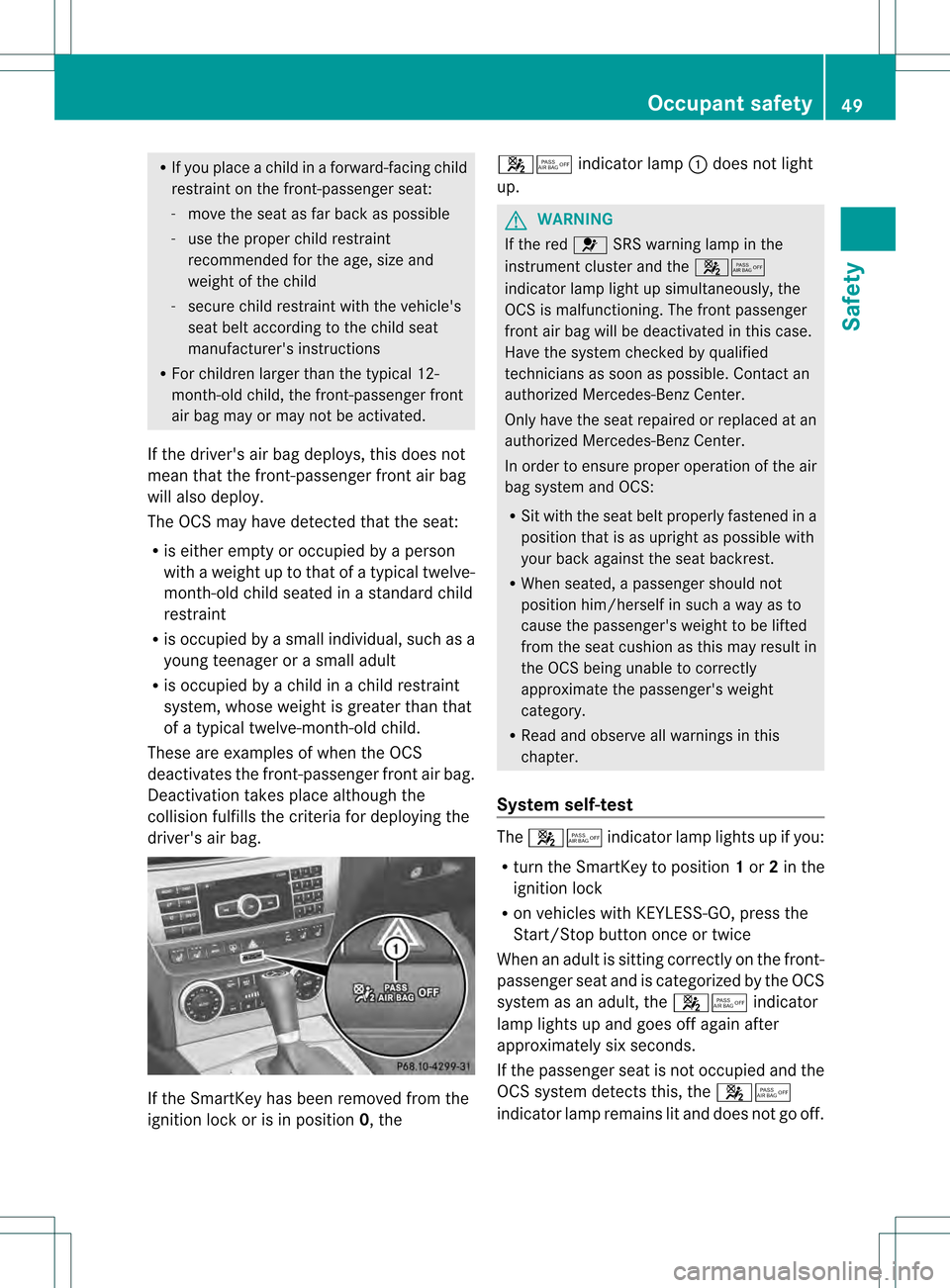
R
If you place a child in a forward-facing child
restraint on the front-passenger seat:
- move the seat as far back as possible
- use the proper child restraint
recommended for the age, size and
weight of the child
- secure child restraint with the vehicle's
seat belt according to the child seat
manufacturer's instructions
R For children larger than the typical 12-
month-old child, the front-passenger front
air bag may or may not be activated.
If the driver's air bag deploys, this does not
mean that the front-passenger front air bag
will also deploy.
The OCS may have detected that the seat:
R is either empty or occupie dby a person
with a weight up to that of a typical twelve-
month-old child seated in astandard child
restraint
R is occupied by a small individual, such as a
young teenager or a small adult
R is occupied by a child in a child restraint
system, whose weight is greate rthan that
of a typical twelve-month-old child.
These are examples of when the OCS
deactivates the front-passenger front air bag.
Deactivation takes place although the
collision fulfills the criteria for deploying the
driver's air bag. If the SmartKey has been removed from the
ignition lock or is in position 0, the0019001B
indicator lamp 0002does not light
up. G
WARNING
If the red 001ESRS warning lamp in the
instrument cluster and the 0019001B
indicator lamp light up simultaneously, the
OCS is malfunctioning. The front passenger
front air bag will be deactivated in this case.
Have the system checked by qualified
technicians as soon as possible. Contact an
authorized Mercedes-Ben zCenter.
Only have the seat repaired or replaced at an
authorized Mercedes-Benz Center.
In order to ensure proper operation of the air
bag system and OCS:
R Sit with the seat belt properly fastened in a
position that is as upright as possible with
your back against the seat backrest.
R When seated, a passenger should not
position him/herself in such a way as to
cause the passenger's weight to be lifted
from the seat cushion as this may result in
the OCS being unable to correctly
approximate the passenger's weight
category.
R Read and observe all warnings in this
chapter.
System self-test The
0019001B indicator lamp lights up if you:
R turn the SmartKey to position 1or 2in the
ignition lock
R on vehicles with KEYLESS-GO, press the
Start/Stop button once or twice
When an adult is sitting correctly on the front-
passenger seat and is categorized by the OCS
system as an adult, the 0019001Bindicator
lamp lights up and goes off again after
approximately six seconds.
If the passenger seat is not occupied and the
OCS system detects this, the 0019001B
indicator lamp remains lit and does not go off. Occupant safety
49Safety Z
Page 58 of 358
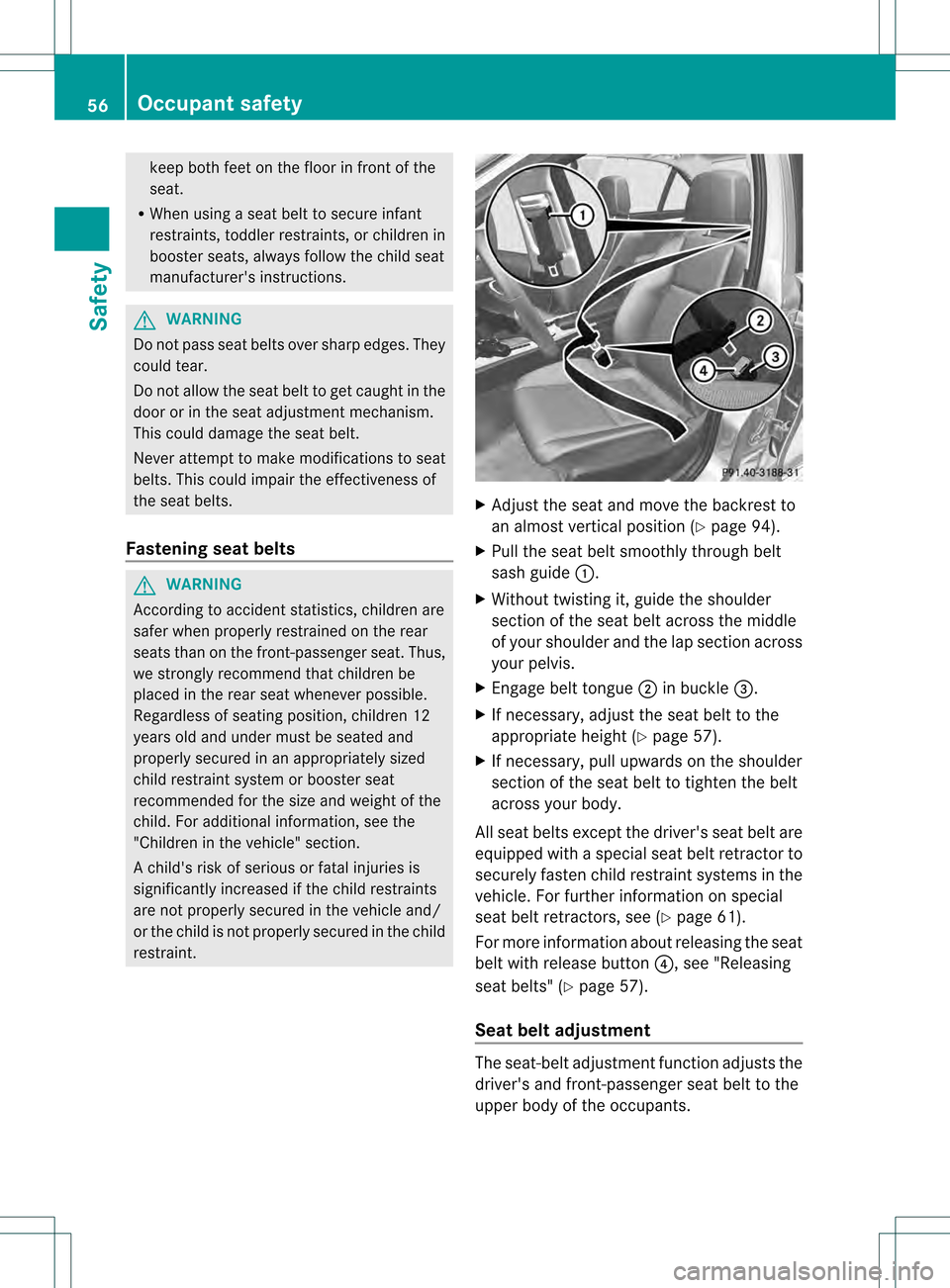
keep both feet on the floor in front of the
seat.
R Whe nusing a seat belt to secure infant
restraints, toddler restraints, or children in
booster seats, always follow the child seat
manufacturer's instructions. G
WARNING
Do not pass seat belts over sharp edges. They
could tear.
Do not allow the seat belt to get caught in the
door or in the seat adjustment mechanism.
This could damage the seat belt.
Never attempt to make modifications to seat
belts. This could impair the effectiveness of
the seat belts.
Fastening seat belts G
WARNING
According to accident statistics, children are
safer when properly restrained on the rear
seats than on the front-passenger seat. Thus,
we strongly recommend that children be
placed in the rear seat whenever possible.
Regardless of seating position, children 12
years old and under must be seated and
properly secured in an appropriately sized
child restraint system or booster seat
recommended for the size and weight of the
child. For additional information, see the
"Children in the vehicle" section.
Ac hild's risk of serious or fatal injuries is
significantly increased if the child restraints
are not properly secured in the vehicle and/
or the child is not properly secured in the child
restraint. X
Adjust the seat and move the backrest to
an almost vertical position (Y page 94).
X Pull the seat belt smoothly through belt
sash guide 0002.
X Without twisting it, guide the shoulder
section of the seat belt across the middle
of your shoulder and the lap section across
your pelvis.
X Engage belt tongue 0003in buckle 0022.
X If necessary, adjust the seat belt to the
appropriate height (Y page 57).
X If necessary, pull upwards on the shoulder
section of the seat belt to tighten the belt
across your body.
All seat belts except the driver's seat belt are
equipped with a special seat belt retractor to
securely fasten child restraint systems in the
vehicle. For further information on special
seat belt retractors, see (Y page 61).
For more information about releasing the seat
belt with release button 0021, see "Releasing
seat belts" (Y page 57).
Seat belt adjustment The seat-belt adjustment function adjusts the
driver's and front-passenger seat belt to the
upper body of the occupants.56
Occupant safetySafety
Page 60 of 358
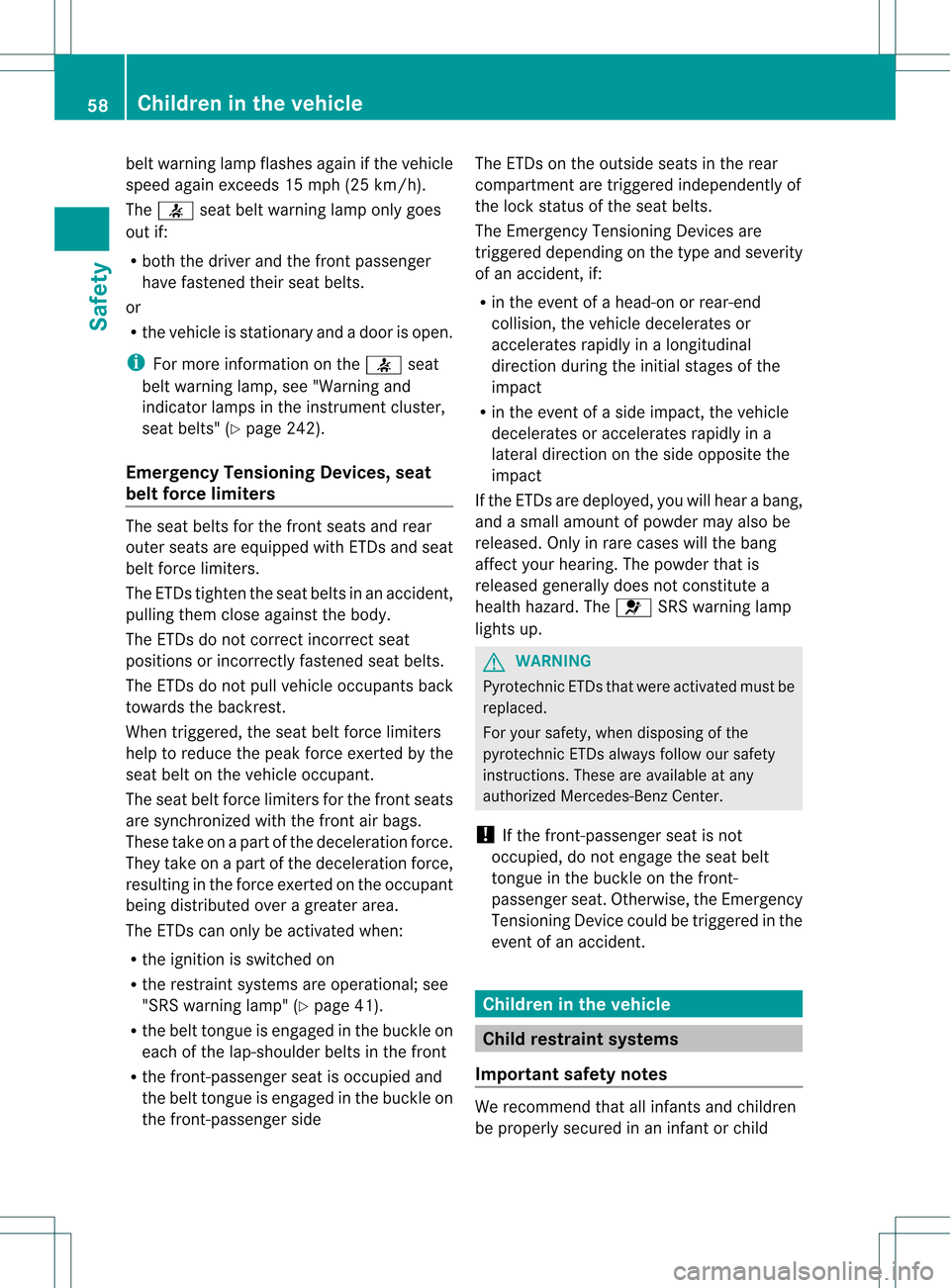
belt warning lamp flashes again if the vehicle
speed again exceeds 15 mph (25 km/h).
The
001F seat belt warning lamp only goes
out if:
R both the driver and the fron tpassenger
have fastened their seat belts.
or
R the vehicle is stationary and a door is open.
i For more information on the 001Fseat
belt warning lamp, see "Warning and
indicator lamps in the instrument cluster,
seat belts" ( Ypage 242).
Emergency Tensioning Devices, seat
belt force limiters The seat belts for the fron
tseats and rear
outer seats are equipped with ETDs and seat
belt force limiters.
The ETDs tighten the seat belts in an accident,
pulling them close against the body.
The ETDs do not correct incorrect seat
positions or incorrectly fastened seat belts.
The ETDs do not pull vehicle occupants back
towards the backrest.
When triggered, the seat belt force limiters
help to reduce the peak force exerted by the
seat belt on the vehicle occupant.
The seat belt force limiters for the fron tseats
are synchronized with the fron tair bags.
These take on a part of the deceleration force.
They take on a part of the deceleration force,
resulting in the force exerted on the occupant
being distributed over a greater area.
The ETDs can only be activated when:
R the ignition is switched on
R the restraint systems are operational; see
"SRS warning lamp" (Y page 41).
R the belt tongue is engaged in the buckle on
each of the lap-shoulder belts in the front
R the front-passenger seat is occupied and
the belt tongue is engaged in the buckle on
the front-passenger side The ETDs on the outside seats in the rear
compartmen
tare triggered independently of
the lock status of the seat belts.
The Emergency Tensioning Devices are
triggered depending on the type and severity
of an accident, if:
R in the event of a head-on or rear-end
collision, the vehicle decelerates or
accelerates rapidly in a longitudinal
direction during the initia lstages of the
impact
R in the event of a side impact, the vehicle
decelerates or accelerates rapidly in a
lateral directio nonthe side opposite the
impact
If the ETDs are deployed, you will hear a bang,
and a small amount of powder may also be
released. Only in rare cases will the bang
affect your hearing. The powder that is
released generally does not constitute a
health hazard. The 001ESRS warning lamp
lights up. G
WARNING
Pyrotechnic ETDs that were activated must be
replaced.
For your safety, when disposing of the
pyrotechnic ETDs always follow our safety
instructions. These are available at any
authorized Mercedes-Ben zCenter.
! If the front-passenger seat is not
occupied, do not engage the seat belt
tongue in the buckle on the front-
passenger seat. Otherwise, the Emergency
Tensioning Device could be triggered in the
event of an accident. Children in the vehicle
Child restraint systems
Important safety notes We recommend that all infants and children
be properly secured in an infan
torchild 58
Children in the vehicleSafety
Page 61 of 358
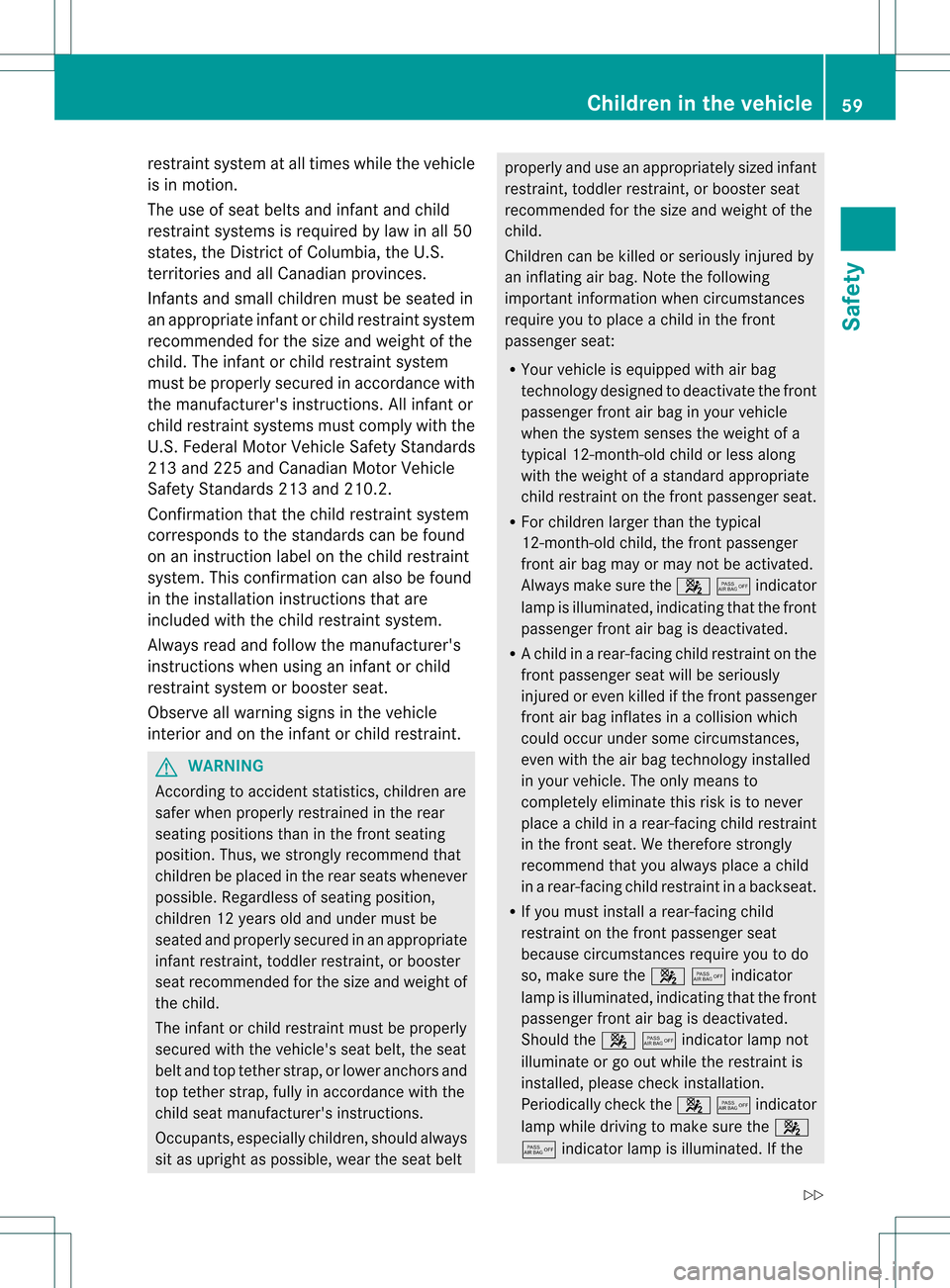
restraint system at all times while the vehicle
is in motion.
The use of seat belts and infant and child
restraint systems is required by law in all 50
states, the District of Columbia, the U.S.
territories and all Canadian provinces.
Infants and small children must be seated in
an appropriate infant or child restraint system
recommended for the size and weight of the
child .The infant or child restraint system
must be properly secured in accordance with
the manufacturer's instructions. All infant or
child restraint systems must comply with the
U.S. Federal Motor Vehicle Safety Standards
213 and 225 and Canadian Motor Vehicle
Safety Standards 213 and 210.2.
Confirmation that the child restraint system
corresponds to the standards can be found
on an instruction label on the child restraint
system. This confirmation can also be found
in the installation instructions that are
included with the child restraint system.
Always read and follow the manufacturer's
instructions when using an infant or child
restraint system or booster seat.
Observe all warning signs in the vehicle
interior and on the infant or child restraint. G
WARNING
According to accident statistics, children are
safer when properly restrained in the rear
seating positions than in the front seating
position. Thus, we strongly recommend that
children be placed in the rear seats whenever
possible. Regardless of seating position,
children 12 years old and under must be
seated and properly secured in an appropriate
infant restraint, toddler restraint, or booster
seat recommended for the size and weight of
the child.
The infant or child restraint must be properly
secured with the vehicle's seat belt, the seat
belt and top tether strap, or lower anchors and
top tether strap, fully in accordance with the
child seat manufacturer's instructions.
Occupants, especially children, should always
sit as upright as possible, wear the seat belt properly and use an appropriately sized infant
restraint, toddler restraint, or booster seat
recommended for the size and weight of the
child.
Children can be killed or seriously injured by
an inflating air bag. Note the following
important information when circumstances
require you to place a child in the front
passenger seat:
R
Your vehicle is equipped with air bag
technology designed to deactivate the front
passenger front air bag in your vehicle
when the system senses the weight of a
typical 12-month-old child or less along
with the weight of a standard appropriate
child restraint on the front passenger seat.
R For children larger than the typical
12-month-old child, the front passenger
front air bag may or may not be activated.
Always make sure the 0019001Bindicator
lamp is illuminated, indicating that the front
passenger front air bag is deactivated.
R Ac hild in a rear-facing child restraint on the
front passenger seat will be seriously
injured or even killed if the front passenger
front air bag inflates in a collision which
could occur under some circumstances,
even with the air bag technology installed
in your vehicle. The only means to
completely eliminate this risk is to never
place a child in a rear-facing child restraint
in the front seat. We therefore strongly
recommend that you always place a child
in a rear-facing child restraint in a backseat.
R If you must install a rear-facing child
restraint on the front passenger seat
because circumstances require you to do
so, make sure the 0019001Bindicator
lamp is illuminated, indicating that the front
passenger front air bag is deactivated.
Should the 0019001Bindicator lamp not
illuminate or go out while the restraint is
installed, please chec kinstallation.
Periodically check the 0019001Bindicator
lamp while driving to make sure the 0019
001B indicator lamp is illuminated. If the Children in the vehicle
59Safety
Z
Page 62 of 358
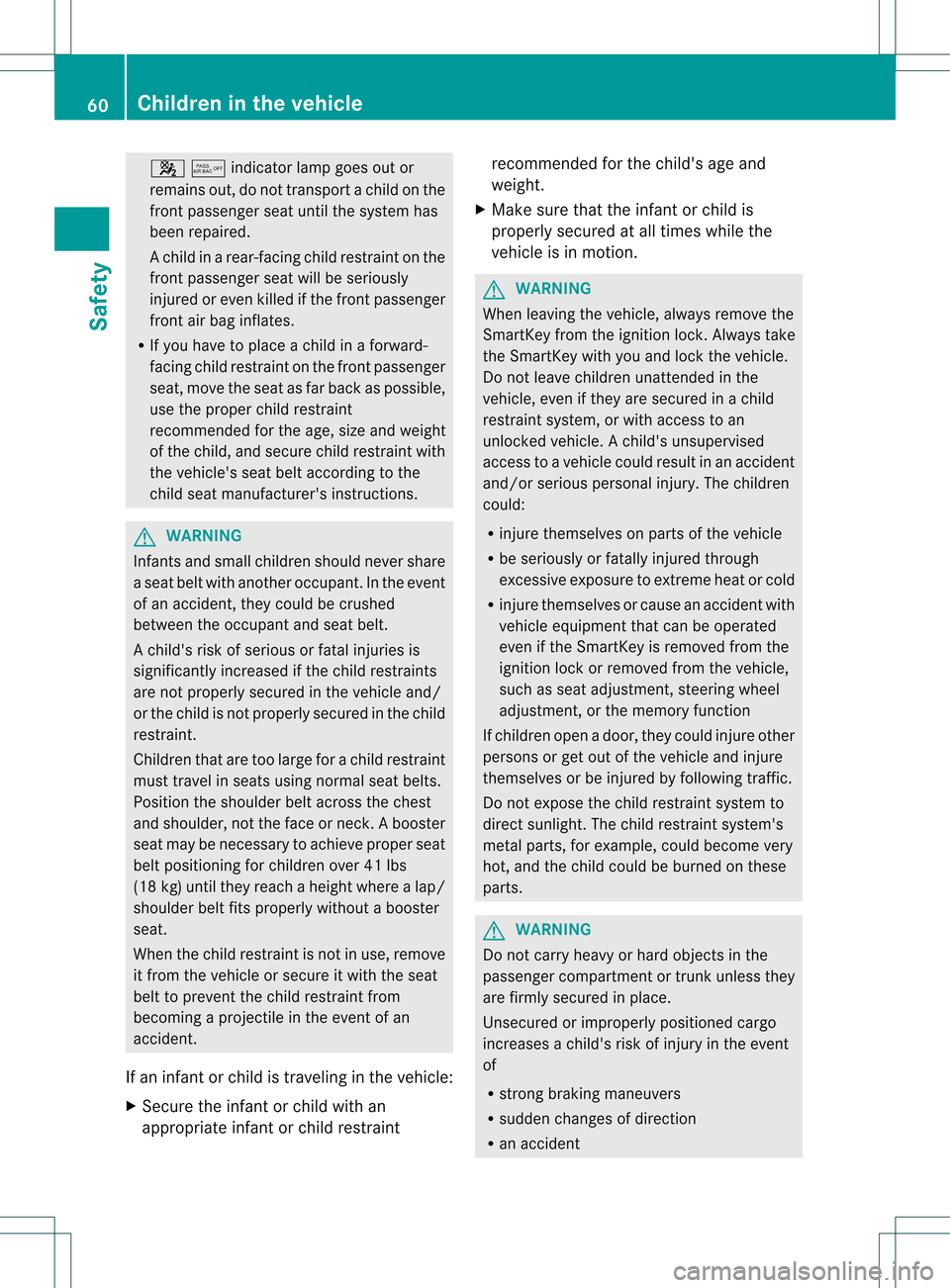
0019001Bindicator lamp goes out or
remains out, do not transport a child on the
front passenger seat until the system has
been repaired.
Ac
hild in a rear-facing child restraint on the
front passenger seat will be seriously
injured or even killed if the front passenger
front air bag inflates.
R If you have to place a child in a forward-
facing child restraint on the front passenger
seat, move the seat as far back as possible,
use the proper child restraint
recommended for the age, size and weight
of the child, and secure child restraint with
the vehicle's seat belt according to the
child seat manufacturer's instructions. G
WARNING
Infants and small children should never share
a seat belt with another occupant. In the event
of an accident, they could be crushed
between the occupant and seat belt.
Ac hild's risk of serious or fatal injuries is
significantly increased if the child restraints
are not properly secured in the vehicle and/
or the child is not properly secured in the child
restraint.
Children that are too large for a child restraint
must travel in seats using normal seat belts.
Position the shoulder belt across the chest
and shoulder, not the face or neck.Ab ooster
seat may be necessary to achieve proper seat
belt positioning for children over 41 lbs
(18 kg) until they reach a height where alap/
shoulder belt fits properly without a booster
seat.
When the child restraint is no tinuse, remove
it from the vehicle or secure it with the seat
belt to prevent the child restraint from
becoming a projectile in the event of an
accident.
If an infant or child is traveling in the vehicle:
X Secure the infant or child with an
appropriate infant or child restraint recommended for the child's age and
weight.
X Make sure that the infant or child is
properly secured at all times while the
vehicle is in motion. G
WARNING
When leaving the vehicle, always remove the
SmartKey from the ignition lock. Always take
the SmartKey with you and lock the vehicle.
Do not leave children unattended in the
vehicle, even if they are secured in a child
restraint system, or with access to an
unlocked vehicle. Achild's unsupervised
access to a vehicle could result in an accident
and/or serious personal injury. The children
could:
R injure themselves on parts of the vehicle
R be seriously or fatally injured through
excessive exposure to extreme heat or cold
R injure themselves or cause an accident with
vehicle equipment that can be operated
even if the SmartKey is removed from the
ignition lock or removed from the vehicle,
such as seat adjustment, steering wheel
adjustment, or the memory function
If children open a door, they could injure other
persons or get out of the vehicle and injure
themselves or be injured by following traffic.
Do not expose the child restraint system to
direct sunlight. The child restraint system's
metal parts, for example, could become very
hot, and the child could be burned on these
parts. G
WARNING
Do not carry heavy or hard objects in the
passenger compartmentort runk unless they
are firmly secured in place.
Unsecured or improperly positioned cargo
increases a child's risk of injury in the event
of
R strong braking maneuvers
R sudden changes of direction
R an accident 60
Children in the vehicleSafety